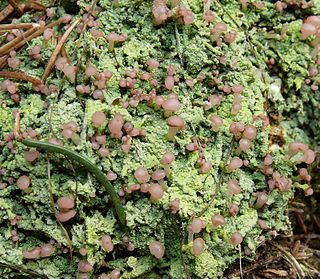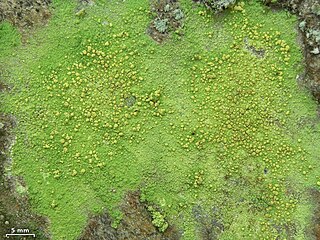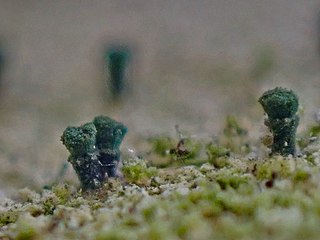
The Cladoniaceae are a family of lichenized fungi in the order Lecanorales. It is one of the largest families of lichen-forming fungi, with about 560 species distributed amongst 17 genera. The reindeer moss and cup lichens (Cladonia) belong to this family. The latter genus, which comprises about 500 species, forms a major part of the diet of large mammals in taiga and tundra ecosystems. Many Cladoniaceae lichens grow on soil, but other can use decaying wood, tree trunks, and, in a few instances, rocks as their substrate. They grow in places with high humidity, and cannot tolerate aridity.
Scutula is a genus of lichenicolous fungi in the family Ramalinaceae.

The Baeomycetales are an order of mostly lichen-forming fungi in the subclass Ostropomycetidae, in the class Lecanoromycetes. It contains 8 families, 33 genera and about 170 species. As a result of molecular phylogenetics research published in the late 2010s, several orders were folded into the Baeomycetales, resulting in a substantial increase in the number of taxa.

Psilolechia is a genus of four species of crustose lichens. It is the only member of Psilolechiaceae, a family that was created in 2014 to contain this genus.

Microcalicium is a genus of lichen-forming fungi in the order Pertusariales. It is the only genus in the monotypic family Microcaliciaceae. These taxa were circumscribed by the Finnish lichenologist Edvard August Vainio in 1927, with Microcalicium disseminatum assigned as the type species.

Pycnora is a genus of fungi in the monotypic family Pycnoraceae. It contains three species. The genus was circumscribed by Josef Hafellner in 2001; the family was proposed by Mika Bendiksby and Einar Timdal in 2013.

Candelariaceae is a family of lichen-forming fungi in the order Candelariales. It contains seven genera and about 73 species. The family was circumscribed by Finnish lichenologist Rainar Hakulinen in 1954 to contain the type genus, Candelaria.

Hypocenomyce is a genus of lichen-forming fungi in the family Ophioparmaceae. Species in the genus grow on bark and on wood, especially on burned tree stumps and trunks in coniferous forest. Hypocenomyce lichens are widely distributed in the northern hemisphere.

Solenopsora is a genus of lichen-forming fungi in the family Catillariaceae. It has 15 species, with a mostly Northern Hemisphere distribution.

Schaereria is a genus of lichen-forming fungi. It is the sole genus in the family Schaereriaceae, which itself is the only family in the Schaereriales, an order in the subclass Ostropomycetidae of the class Lecanoromycetes. Most Schaereria species are crustose lichens that live on rocks. Schaereria was first proposed by Gustav Wilhelm Körber in 1855 and was later taken up by other lichenologists despite periods of disuse.
Bibbya is a genus of fruticose lichens in the family Ramalinaceae.

Sporastatiaceae is a small family of crustose lichens in the order Rhizocarpales. It contains two genera, Sporastatia and Toensbergia, with a total of five species. Sporastatiaceae was circumscribed in 2013 by Mika Bendiksby and Ernst Timdal.
Toensbergia is a genus of lichen-forming fungi in the family Sporastatiaceae. The genus was circumscribed by Mika Bendiksby and Einar Timdal in 2013. The genus name honours Norwegian lichenologist Tor Tønsberg, "in appreciation of his important work on sorediate, corticolous lichens". The type species is Toensbergia leucococca, which was formerly classified in genus Hypocenomyce, presumably due to its resemblance to Hypocenomyce xanthococca.

Rhizocarpales are an order of lichen-forming fungi in the subclass Lecanoromycetidae of the class Lecanoromycetes. It has two families, Rhizocarpaceae and Sporastatiaceae, which contain mostly crustose lichens.

Sporastatia is a genus of crustose lichens in the family Sporastatiaceae. It has four species. Sporastatia lichens are long-lived species that grow on siliceous or weakly calcareous rocks in arctic and alpine locales.

Massalongiaceae is a small family of lichen-forming fungi in the order Peltigerales. It has three genera and seven species.
Cameronia is a genus of crustose lichens in the monotypic family Cameroniaceae. It has two species. Both the genus and its two species were described as new to science in 2011 by Australian lichenologist Gintaras Kantvilas. Characteristics of the genus include its chlorococcalean photobiont partner, and perithecioid ascomata that are deeply immersed in the substrate. Microscopic features of Cameronia include the four-spored asci with an intensely hemiamyloid outer wall and non-amyloid, well-developed tholus, and hyaline, muriform ascospores. Both species are endemic to the Tasmanian Highlands.
Austrotrema is a genus of lichen-forming fungi in the family Graphidaceae. It is primarily found in the Australian-Southeast Asian region. The genus is characterized by small, pore-like apothecia with a double margin, faintly amyloid ascospores, and stictic acid chemistry. Austrotrema species grow on tree bark and have a continuous thallus with a cortex that is prosoplectenchymatous–featuring densely packed, filamentous fungal hyphae that run parallel to the surface of the lichen, creating a compact and firm texture. The genus is closely related to Thelotrema and Leucodecton, but can be distinguished from them based on molecular phylogenetic data, specific morphological traits, and its secondary chemistry. Currently, Austrotrema comprises three species.
Candelinella is a genus of lichen-forming fungi in the family Candelariaceae. It contains two species of crustose lichens. It is visually similar to the genus Candelina but has unique features, including a distinct thallus and unique spore structures. It was established by Sergey Kondratyuk in 2020, with Candelinella makarevichiae assigned as the type species. The genus is distinguished by the small, crustose thallus that ranges from a granular to areolate or squamulose texture, and the simple to 1-septate, narrowly ellipsoid to oblong ascospores. Its lack of a lower cortex and medulla further sets it apart from Candelina.
Aspiciliopsis is a genus of lichen-forming fungi in the family Trapeliaceae. It has two species, both of which occur in the Southern Hemisphere.













